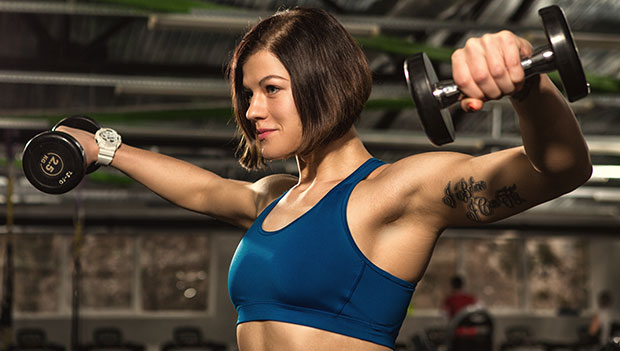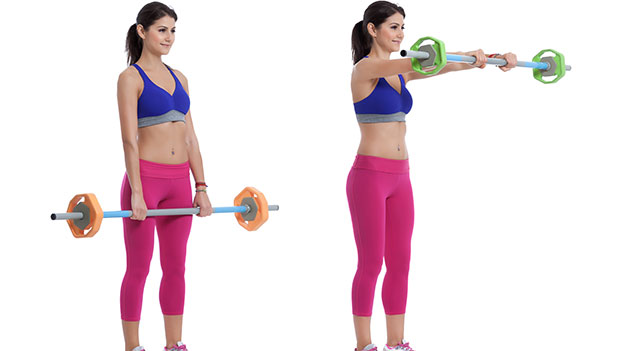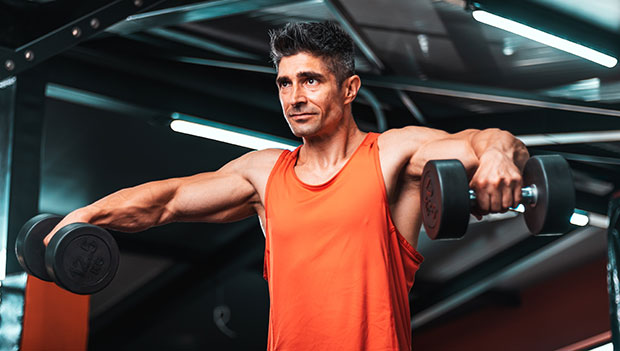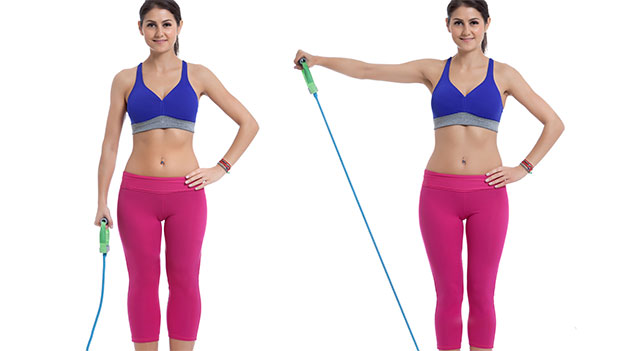
How to Build Muscle | Muscle-Building Nutrition | Muscle-Building Supplements | Hypertrophy Training | Strength Training | Chest Workouts | Back Workouts | Arm Workouts | Shoulder Workouts | Leg Workouts
When you work on building muscle, the goal isn’t just to increase size, it’s to improve appearance as well. Those "boulder shoulders" should be getting more toned as they get bigger and rounder. Before we can make that goal a reality, we need to ask: What muscles make up the shoulders? Which shoulder workouts are best for each of those muscles?
We need to be aware of the risk that comes with the potential reward of targeting this area—the shoulders are very susceptible to injury because of their involvement in so many other exercises and activities. That’s why it’s important to know the anatomy, proper form, and what you can do both in and out of the weight room to keep those shoulders healthy.
In this guide, we’ll give you a brief introduction to the anatomy of the shoulders and share the best exercises to help you develop those shoulders in the safest ways possible. We will then go over the best rep ranges and shoulder workouts to build muscle and help you reach your individual goals using common home-gym equipment.
Shoulder Anatomy
The rotator cuff is the key support of the shoulder joint. This is a group of muscles and tendons that help stabilize the shoulder. Every time you move your entire arm, the rotator cuff is working.
Aside from the rotator cuff, there are three major parts, or heads, that make up the deltoid. The front head (anterior head) is activated when you lift the arm up in front of you or press overhead. The side (lateral) head is used when your arms go up to the sides and they also help with stability during other motions. The third part is the rear (posterior) head. When your arm is elevated and you pull it back, the rear delts are doing the majority of the work. Likewise, the rear deltoids are the primary muscle involved in exercises like an upright row.
Shoulder Exercises
There is no way to completely isolate one individual muscle within the shoulder, but there are exercises that require one muscle to be more active than the others. In this section, we’ll break down which workouts are best to target those specific muscles with the equipment you may already have at home.
Barbell and Plates
Athletes with strength goals should have access to a barbell and weight plates. Free weights are a great asset for strength-building. The barbell requires both sides of the body to move one object together. This allows you to move more weight than if you were to divide the same amount of weight into each hand with dumbbells. These three exercises are all great for building size and strength:
Front Head: Front Barbell Raise

Hold a barbell at your thighs with a shoulder-width grip in a standing position. Stick your chest out and keep your core tight. While keeping your arms straight, lift the bar up in front of you until it is at shoulder height. Pause briefly at the top to get the most out of the contraction. Slowly lower the bar back to the starting position and repeat for the desired number of reps.
Side Head: Wide-Grip Upright Row
Stand, holding a barbell at your thighs with a shoulder-width grip—or even a little wider if it’s more comfortable. Stand straight and tall and brace your core. Bend your elbows and lift the barbell up to about your collarbone. Slowly lower the bar back to your starting position and repeat for the desired reps.
Rear Head: Wide-Grip Bent-Over Row
Stand tall with a barbell in your hands wider than shoulder-width apart. Keeping your legs straight, bend at the hips until your upper body is almost parallel to the floor. Your arms should be hanging down while holding the bar, which should be below your knees. Bend your elbows and pull the bar up to your chest (not your waist like the back version of this exercise). Squeeze the shoulders when the bar reaches the top. Slowly lower the bar back to the starting position and repeat for the desired reps. When you finish the set, lower the bar to the floor.
Dumbbells
While barbells are a great choice for strength, there may not be a more versatile tool for training than dumbbells. Using dumbbells forces each side of the body to work independently of the other side. You also have to stabilize the weight and work harder to maintain control. Both factors are important in the muscle-building process. Each exercise below can help you take your shoulder development to a new level.
Front Head: Standing Dumbbell Press
Stand and hold a dumbbell in each hand. Lift the dumbbells up to your shoulders with your elbows bent and your palms facing away from you. Keep your legs straight and your abs tight. From this starting position, press the dumbbells up over your head until your arms are straight. Slowly lower the dumbbells back to the start and repeat for the desired number of reps.
Side Head: Lateral Dumbbell Raise

Stand and hold a dumbbell in each hand. Your arms should be at your sides and have a slight bend. Your palms should be facing each other. Lift the weights straight up and out to the sides. Your elbows should stay higher than your hands. Lift until your upper arms are parallel with the floor. Slowly lower your arms back down to your sides and repeat.
Rear Head: Rear-Delt Dumbbell Fly
Hold a dumbbell in each hand with your palms facing toward you. Bend over at the hips until your upper body is almost parallel with the floor. Lift your arms up and out to the sides while you’re in this bent-over position. Bring your arms up as far as you can and briefly pause. Slowly lower your arms back to the starting position and repeat.
Cables or Bands
Many lifters like to train in health clubs and gyms because of the ability to use cables. Cables help isolate muscle groups and they keep you in a fixed position. This is generally safer for athletes who want to perform movements more slowly. The advantage is that you can maintain constant muscle tension from start to finish.
Many home gym trainees don’t have access to a cable system but luckily resistance bands can be used for many of the same exercises that are usually performed with cables. The major difference is that the band’s tension isn’t constant throughout the movement—it increases as you stretch the band and it decreases as you return to the starting position.
A bonus to bands is that you can take them with you anywhere to fit a session in. These three exercises make for a nice shoulder circuit or workout.
Front Head: Single-Arm Shoulder Press
Stand in the middle of a resistance band and hold both ends in one hand. If you’re using a cable, grab the individual handle attached to a low cable pulley. Lift the hand up to shoulder height with your elbow bent. Keep your legs straight and core tight. From this starting position, straighten your arm by pressing over your head. Slowly lower the hand back to the start and repeat.
Side Head: Single-Arm Lateral Raise

Stand on the center of a resistance band and hold a handle in each hand. If you’re using a cable pulley, use the same single handle and low pulley as you would for the single-arm shoulder press. Your palm should be facing inward. Lift one arm straight up to the side until the arm is parallel with the floor. Hold this position for a count of one before lowering your arm back to the starting position. When you finish performing reps with the first arm, do the same with the other.
Rear Head: Face Pull
Wrap your band around a high object like a pillar or beam or connect a rope attachment to an upper cable pulley. Hold one end of the band or rope in each hand and step back until your arms are stretched forward at shoulder height. Bend your elbows and pull your hands back. Spread your hands apart during this motion so your hands end up around your ears and your rear delts are contracted. Slowly release your hands back to the starting position and repeat.
Putting It All Together
Since the shoulders are so continuously engaged during other exercises, you don’t need to do much direct work to see results. If you only have one of these equipment options, then you can still work each of the deltoid heads—either perform the three exercises individually for 3-4 sets each or as a circuit together. Circuits are great if you’re short on time but building muscle requires recovery so taking 90-120 seconds between sets would make each workout more impactful. Since the goal for these workouts is to build larger and more defined shoulders, the best rep range to work with is 8-12 reps per set.
For example, if you were going to do a shoulder workout with only dumbbells, it may look like this:
- Standing Dumbbell Press: 3-4 sets of 8-12 reps
- Lateral Dumbbell Raise: 3-4 sets of 8-12 reps
- Rear-Delt Dumbbell Fly: 3-4 sets of 8-12 reps
If you happen to have barbells, dumbbells, and bands—or if you train in a gym—then you can pick one movement from each of these groups and make your own workout.
An example of this may look like this:
- Front Barbell Raise: 3-4 sets of 8-12 reps
- Lateral Dumbbell Raise: 3-4 sets of 8-12 reps
- Face Pull: 3-4 sets of 8-12 reps
The great part of training to build muscle is that you can keep your workouts interesting by swapping in and out whichever deltoid exercises you want, which may even bring you better results.
Regardless of which equipment you have or prefer, train your shoulders with focus and intensity every five to seven days, and you should be pleased with your results in a matter of a few months.
How to Build Muscle | Muscle-Building Nutrition | Muscle-Building Supplements | Hypertrophy Training | Strength Training | Chest Workouts | Back Workouts | Arm Workouts | Shoulder Workouts | Leg Workouts


